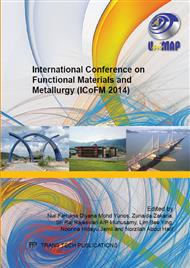p.256
p.262
p.268
p.274
p.280
p.284
p.290
p.295
p.303
Nanostructured WO3 – Synthesis and Properties
Abstract:
Porous tungsten oxide (WO3) nanofibers were synthesized by electrospinning aqueous solutions of polyvinylpyrrolidone (PVP) and ammonium metatungstate (AMT). The as-spun fibers and their annealing were studied by scanning electron microscope (SEM). SEM results showed that the WO3 fibers have a large amount of pores with diameters ranging from 50 nm to 100 nm, and pure monoclinic WO3 nanoscaled fibers formed between 500 and 600 °C. When a higher temperature (700 °C) was used, the tungsten oxide nanofibers totally disintegrated. When heated at 600 °C, the fibers broken into nanorods by the mechanical pressure. However, when the annealing treatment was low (500 °C), the fiber-like crystalline structure that can be seen. When the optimal temperature was used, the structure of the obtained WO3 nanofibers with novel morphology and crystallinity were captured.
Info:
Periodical:
Pages:
280-283
Citation:
Online since:
June 2015
Authors:
Keywords:
Price:
Сopyright:
© 2015 Trans Tech Publications Ltd. All Rights Reserved
Share:
Citation:


